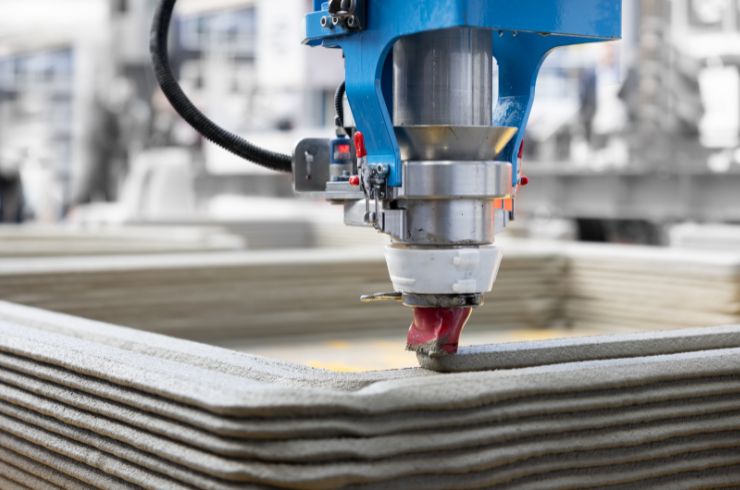From food to clothing and furniture, 3D printing has become a powerful tool for makers and creators everywhere, allowing them to create unique products through the power of digital fabrication without breaking the budget. But what about concrete 3D printing?
Over the past few years, concrete 3D printing has dramatically impacted the construction industry, offering architects and engineers new opportunities to create structures with unprecedented speed and precision.
What advantages does this technology provide, and what challenges remain before it can reach its maximum potential? In this article, we will explore both the advantages and challenges of concrete 3D printing and the future of this exciting technology.
Concrete 3D Printing: Advantages and Challenges
Compared to traditional construction methods, concrete 3D printing is faster, more cost-effective, and can produce structures with unique designs that may be impossible with conventional methods. Despite these advantages, this technology must address many challenges before becoming widely adopted.
What Is Concrete 3D Printing?
Unlike traditional methods of construction, which involve pouring layers of concrete and reinforcing them with steel bars, concrete 3D printing uses a robotic arm to print layers of cement-based material directly onto a prepared surface.
As an example, we’ll demonstrate how to print a house in 3D. The process starts with creating a digital model that can be edited using 3D design software. Afterward, a 3D concrete printer combines concrete, sand, and other materials to print 3D structures using a robotic arm and a nozzle to deposit layers of material according to design specifications, one layer at a time, until the desired object is formed. The layers are then compressed and cured with a curing agent such as steam or ultraviolet light. Eventually, the result is a replica of the digital model created in the software.
Advantages of Concrete 3D Printing
As a major development in the construction industry, concrete 3D printing brings about several significant advantages.
Reduced Construction Waste
This technology can help minimize the environmental impact of construction activities, as it reduces the consumption of natural resources by utilizing less material for the same structure. Additionally, using concrete printers also helps reduce waste from construction sites as it produces no leftover material during the printing process.
That makes concrete 3D printing an advantageous alternative to traditional building methods that require large amounts of materials and generate significant waste. Overall, 3D printing construction materials effectively reduce consumption while meeting construction requirements.
Flexibility
Unlike traditional construction methods, creating custom designs with concrete 3D printing in a fraction of the time and cost is possible. 3D concrete printers offer rapid prototyping, which helps to reduce design costs and lead times. Furthermore, concrete prints can easily be scaled up or down depending on the project requirements, allowing for greater flexibility when constructing different buildings.
In addition, integrating technologies such as BIM (Building Information Modeling) and AR (Augmented Reality) expedites design decisions and modifications, which results in better accuracy, higher quality, and improved safety of the construction project.
Ultimately, this added flexibility opens up new possibilities for architectural designs that were impossible before due to material limitations or cost restrictions.
Lower Labor Costs
Concrete 3D printing eliminates the need for workers to manually pour and form concrete and the need for scaffolding and other support structures that require a workforce to build. This can lead to great cost savings for contractors and developers and faster project completion times due to fewer workers being required on-site. The technology also allows precise control of the concrete’s shape and structure, improving building strength and longevity.
Challenges of Concrete 3D Printing
Concrete 3D printing is quickly becoming one of the most sought-after construction technologies. However, several challenges still need to be addressed before this technology can be considered a viable solution for large-scale construction projects.
Material Properties and Compatibility
Using additive manufacturing for concrete printing requires materials suitable for this purpose and compatible with the environment in which they are printed. Hence, various components must be considered when selecting the optimum material for 3D printing, including strength, durability, chemical resistance, heat transfer characteristics, dimensional accuracy, and moisture absorption. Consequently, understanding these parameters is essential for achieving a successful 3D printed structure.
In addition, concrete 3D printing also calls for an understanding of different curing methods and their impact on finished products. For example, 3D printing a cement house involves several steps beginning with the preparation of raw materials to the final curing processes that could significantly influence the quality and longevity of the structure made by this method.
3D Printer Size
The larger the build area, the more complicated it becomes to design and construct a concrete 3D printer. Hence, it is essential to consider the printer’s dimensions and weight relative to the printed structures’ size.
This means larger structures require larger printers and heavier materials, making transporting and setting up on-site difficult. Developing large-scale concrete printers and maintaining them can also be expensive due to their complex internal components and machinery. Therefore, controlling printer size is essential for successful concrete 3D printing projects as it can limit the cost and time factors involved in the project development.
Cost-Effectiveness
Cost-effectiveness is a major challenge limiting the large-scale adoption of concrete 3D printing technologies. The cost of materials and printers and the complexity of the process can make concrete 3D printing expensive and difficult to scale up.
While concrete 3D printing can build structures and shapes that would be difficult or impossible with conventional construction methods, it often requires dedicated skills and expertise in design and engineering. Such skills contribute to additional project costs, not to mention the lack of skilled personnel available to operate these 3D printers, which also presents a challenge when trying to reduce costs and maximize efficiency.
The Future of Concrete 3D Printing
From multi-story buildings to intricate structures, the outlook for concrete 3D printing promises great possibilities, with the market size expected to reach $1,256.5 billion by 2031. This technology has allowed us to explore new ways of building complex designs that would otherwise take too much time or cost too much money to produce with traditional methods. Furthermore, it also opened up opportunities for sustainable construction as it uses fewer resources than conventional methods.
Still, the technology faces significant roadblocks to widespread adoption in construction projects. Such challenges include addressing material properties and compatibility challenges, printer size and speed constraints, and cost-effectiveness.
Hence, experts in the field should strive to develop more efficient production processes, reduce labor costs and optimize energy consumption. Once their efforts prove to be successful, concrete 3D printing could soon become quite a cost-effective option for construction projects.
Indeed, with the development and introduction of new efficient and cost-effective materials, companies will embrace this technology as a viable solution for their projects. Printers will also become even smarter and more capable thanks to the advancements in artificial intelligence (AI) and machine learning (ML). That would create many exciting possibilities for designers looking for innovative project solutions.
Concrete 3D printing technology will significantly impact the construction industry in the coming years. Additionally, as the technology continues to improve, we can expect to see even more innovative and sustainable building solutions emerge from concrete 3D printing.




